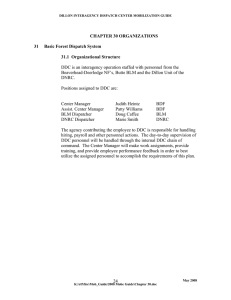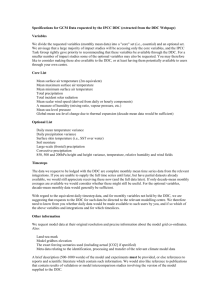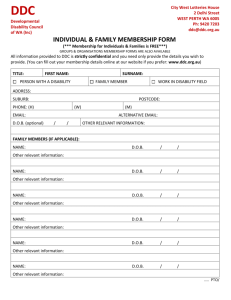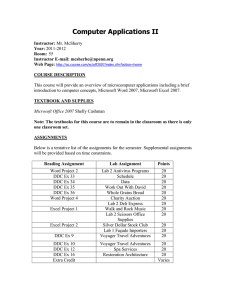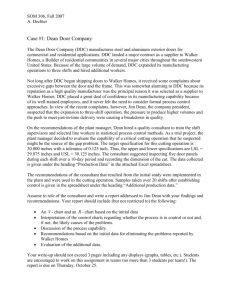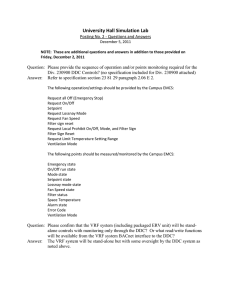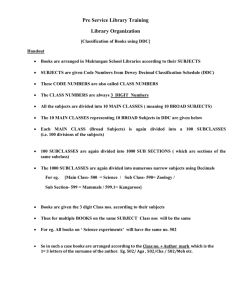DEEP DYNAMIC COMPACTION OF LIQUEFACTION-POTENTIAL GRANULAR BACKFILL
advertisement
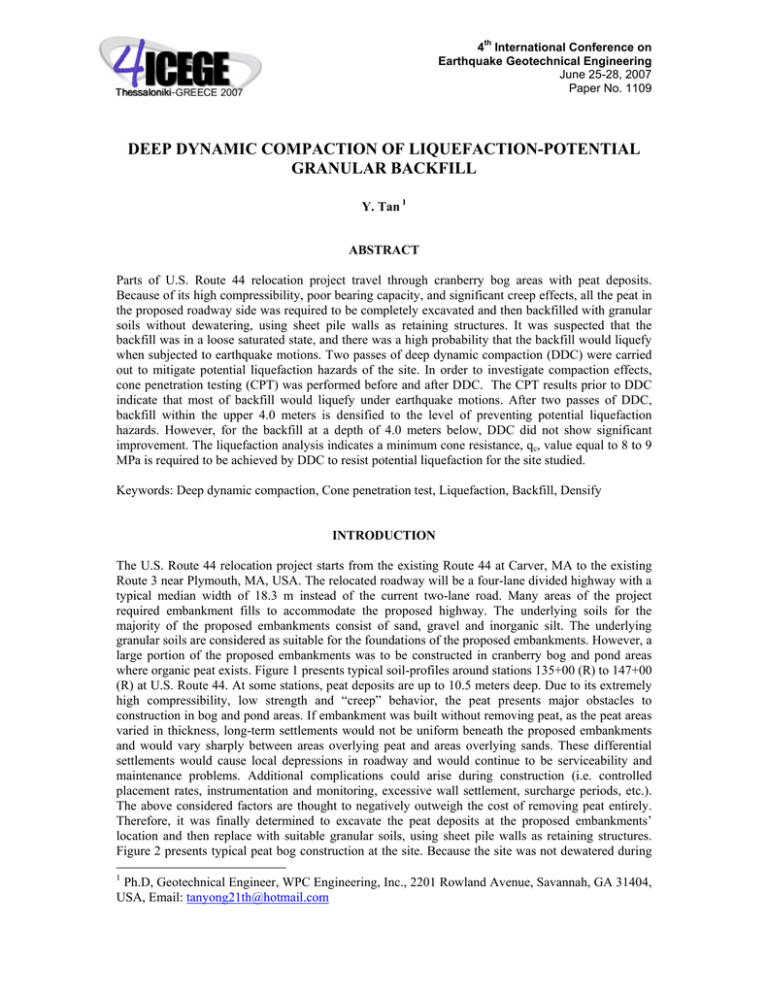
4th International Conference on Earthquake Geotechnical Engineering June 25-28, 2007 Paper No. 1109 DEEP DYNAMIC COMPACTION OF LIQUEFACTION-POTENTIAL GRANULAR BACKFILL Y. Tan 1 ABSTRACT Parts of U.S. Route 44 relocation project travel through cranberry bog areas with peat deposits. Because of its high compressibility, poor bearing capacity, and significant creep effects, all the peat in the proposed roadway side was required to be completely excavated and then backfilled with granular soils without dewatering, using sheet pile walls as retaining structures. It was suspected that the backfill was in a loose saturated state, and there was a high probability that the backfill would liquefy when subjected to earthquake motions. Two passes of deep dynamic compaction (DDC) were carried out to mitigate potential liquefaction hazards of the site. In order to investigate compaction effects, cone penetration testing (CPT) was performed before and after DDC. The CPT results prior to DDC indicate that most of backfill would liquefy under earthquake motions. After two passes of DDC, backfill within the upper 4.0 meters is densified to the level of preventing potential liquefaction hazards. However, for the backfill at a depth of 4.0 meters below, DDC did not show significant improvement. The liquefaction analysis indicates a minimum cone resistance, qc, value equal to 8 to 9 MPa is required to be achieved by DDC to resist potential liquefaction for the site studied. Keywords: Deep dynamic compaction, Cone penetration test, Liquefaction, Backfill, Densify INTRODUCTION The U.S. Route 44 relocation project starts from the existing Route 44 at Carver, MA to the existing Route 3 near Plymouth, MA, USA. The relocated roadway will be a four-lane divided highway with a typical median width of 18.3 m instead of the current two-lane road. Many areas of the project required embankment fills to accommodate the proposed highway. The underlying soils for the majority of the proposed embankments consist of sand, gravel and inorganic silt. The underlying granular soils are considered as suitable for the foundations of the proposed embankments. However, a large portion of the proposed embankments was to be constructed in cranberry bog and pond areas where organic peat exists. Figure 1 presents typical soil-profiles around stations 135+00 (R) to 147+00 (R) at U.S. Route 44. At some stations, peat deposits are up to 10.5 meters deep. Due to its extremely high compressibility, low strength and “creep” behavior, the peat presents major obstacles to construction in bog and pond areas. If embankment was built without removing peat, as the peat areas varied in thickness, long-term settlements would not be uniform beneath the proposed embankments and would vary sharply between areas overlying peat and areas overlying sands. These differential settlements would cause local depressions in roadway and would continue to be serviceability and maintenance problems. Additional complications could arise during construction (i.e. controlled placement rates, instrumentation and monitoring, excessive wall settlement, surcharge periods, etc.). The above considered factors are thought to negatively outweigh the cost of removing peat entirely. Therefore, it was finally determined to excavate the peat deposits at the proposed embankments’ location and then replace with suitable granular soils, using sheet pile walls as retaining structures. Figure 2 presents typical peat bog construction at the site. Because the site was not dewatered during 1 Ph.D, Geotechnical Engineer, WPC Engineering, Inc., 2201 Rowland Avenue, Savannah, GA 31404, USA, Email: tanyong21th@hotmail.com this process, it is suspected that the backfill was in a loose saturated state, which has a high probability of liquefying when subjected to earthquake motions. In order to mitigate potential liquefaction hazards at the project site, two passes of deep dynamic compaction (DDC) were employed to densify the backfill. STATION NUMBER (Distance between stations is 100 ft) 135+00 136+00 137+00 138+00 139+00 140+00 141+00 142+00 143+00 144+00 145+00 146+00 147+00 130 ELEVATION, Ft., MSL 120 1 feet = 0.3048 m rface Existing Ground Su 110 100 PEAT 90 80 70 Fine to Coarse Sand 60 Figure 1. Typical soil-profiles around stations 135+00 (R) to 147+00 (R) at U.S. Route 44 The objective of this study is to verify whether backfill has been densified by DDC to the level of mitigating potential liquefaction hazards during earthquake motions, using the in-situ CPT data obtained prior to and after DDC, respectively. The minimum cone resistance, qc, value required to be achieved by DDC to resist potential liquefaction is also studied. SOIL CONDITIONS The backfill depth at the project site ranges between 2.5 and 10.5 m. According to sieve analysis results (refer to Figure 3), the backfill mainly consists of fine to coarse sand, with a trace of gravel and silt. It could be defined as liquefiable soil according to Tsuchida (1970). Based on the triaxial tests on the representative backfill samples, its effective friction angle, φ ′ , is around 32°. The backfill is underlain by medium to dense natural sand. Before DDC was planned to be applied, it was very important to determine whether the backfill could be improved by DDC. Mitchell (1982) identified soils according to grain size distribution and suggested that most granular soils with a fine content (particles sizes< 0.064 mm) lower than 10% could be compacted by vibratory and impact methods. According to his criterion, the backfill at Rt. 44 lies in the boundary of compactable. The disadvantage of the criterion developed by Mitchell (1982) is that soil samples at different depths have to be taken (Massarch, 1991). It is preferable here to use the compaction criterion developed by Massarch (1991) based on cone resistance, qc, and friction ratio, Rf, assuming homogeneous soil conditions. In the case of thin layers of silt and clay, the effectiveness of compaction will be reduced. Figure 4 present soil identification of backfill for DDC improvement at different stations at Route 44. The soil identification in Figure 4 is using the procedure developed by Robertson and Campanella (1983) and the compaction criterion is defined by Massarch (1991). Most backfill at the site is classified as compactable and marginally compactable soils which are considered suitable for DDC improvement. CL Ave.10.7 m 4.6 m 3.0 m Ave. 4.3 m Route 44 Not to Scale 3.7 m MSE Wall Steel Strip Sheet Pile Access Road Existing Grade 1.2 m Min. Existing Grade 0.9~1.5 m Peat Backfill On-site sand CL Figure 2. Typical peat bog construction at U.S. route 44 (modified from Tan 2005) U.S. Standard Sieve Sizes Cobble Gravel Sand Silt Clay 0 Grain size distribution curve Most liquefiable (Tsuchida, 1970) Potentially liquefiable (Tsuchida, 1970) 90 Percent finer by weight (%) 80 70 10 20 30 Sieve Analysis (Miller et al. 2006) 60 40 50 50 40 60 30 70 20 80 10 90 0 100 10 1 0.1 Diameter (mm) 0.01 0.001 Percent coarser by weight (%) 100 100 0.0001 Figure 3. Grain-size distribution of the backfill at U.S. Rt. 44 (from Tan 2005) 1 40 Sands 20 Silty Sands 9 8 7 6 5 4 Marginally Compactable 3 6 7 40 Compactable 30 Cone Resistance, qc (MPa), prior to DDC Friction Ratio, Rf (%), prior to DDC 2 3 4 5 101+00 117+00 118+00 140+00 142+00 144+00 30 Clay 3 20 9 8 7 6 5 4 Sands Silts and Silts Clayey Silts and Silty Clay 2 2 Not Compactable 0.9 0.8 0.7 0.6 0.5 0.4 0.9 0.8 0.7 0.6 0.5 0.4 Peat 0.3 0.3 0.2 0.2 0.1 0.1 0 1 2 3 4 5 6 Cone Resistance, qc (MPa), prior to DDC 0 7 Friction Ratio, Rf (%), prior to DDC Figure 4. Soil identification of backfill for DDC improvement (after Massarch 1991) DEEP DYNAMIC COMPACTION (DDC) Deep dynamic compaction (DDC) is commonly used to densify coarse, unsaturated soils by vibrating soil for soil particles rearrangement thereby decreasing void volume and making soils denser. The mechanism of densification of saturated soils by DDC is based on dynamic consolidation (Ye et al., 1992). The shock wave caused by dynamic compaction can be classified as volumetric wave and boundary wave according to their way of propagation in soils and their influence on soils. Volumetric waves can be classified as compression wave and shear waves (or horizontal wave and vertical wave). Compacted energy is transmitted from the ground surface to deeper layers by propagating shear and compression waves, which expels out the water trapped between soil particles. As a result, “crack” is formed in soils, allowing rapid dissipation of pore pressure generated during DDC. Then, soils consolidate and soil particles are forced into a denser state. The boundary waves propagate along ground surface, which can not densify soil particle but make ground surface loose. According to Ye et al. (1992), three different areas are formed along depth as a result of DDC. Figure 5 illustrates DDC effects on saturated granular soils. The loose area is formed in topsoil due to the disturbance caused by boundary waves and shear waves. Consolidation area is formed below loose area, due to the densification caused by compression wave. Below consolidation area, shock waves decrease with depth and can not provide enough energy to cause plastic deformation and hence densification in soil. This area is called elastic area. The backfill at Rt. 44 was impacted by two passes of a 14.4-ton tamper with a base area of 1.8 m2, dropped from a height of 18.3 m. Each tamping point was repeatedly impacted nine times. The time interval between the two passes was six days. Figure 6 presents a typical DDC square grid-pattern with a spacing of 4.6 m and the locations of CPT soundings used in this study. The second pass of DDC was conducted at the center spacing of the first pass. The distance between tamping locations and sheet pile wall was no less than 4.6 m to avoid unexpected large sheeting deflection during DDC. Following the completion of each pass of DDC, all the craters caused by DDC were filled and compacted by rollers. Sheet Pile Disturbance area Backfill Consolidation area Peat Bog Elastic area In-situ sands In-situ sands Figure 5. Illustration of DDC effects in saturated granular soils (from Tan, 2005) 4.6m 4.6m 4.6m PEAT BOG Backfill 4.6m 4.6m 4.6m PEAT BOG Sheet Pile Wall 4.6m 4.6m Sheet Pile Wall 4.6m Backfill outside DDC Treated Area 4.6m 13.8m Backfill inside DDC treated Area 4.6m 2.3m 30.5m 30.5m 2.3m CL CL 4.6m CL 4.6m 13.8m 4.6m 4.6m 4.6m Backfill inside DDC Treated Area 4.6m 4.6m 4.6m Backfill Sheet Pile Wall PEAT BOG Sta.140+00 (a) DDC Grid-Pattern DDC CRATER (the First Pass) Backfill outside DDC Treated Area Not to Scale Sta.141+00 Sta.142+00 (b) CPT Sounding Location DDC CRATER (the Second Pass, six days later) CPT Sounding Figure 6. Typical deep dynamic compaction (DDC) grid-pattern at U.S. Rt. 44 CONE PENETRATION TESTING (CPT) A series of cone penetration tests (CPT) were carried out inside and outside the compaction-treated area to evaluate compaction effects. The initial evaluation test (EI) was conducted prior to the start of DDC. The second test (EV1) was conducted following the completion of the first pass. The subsequent third test (EV2) was conducted following the completion of the second pass. In this paper, only the CPT results inside the compaction-treated area are presented and discussed. The CPT soundings were located at the center spacing of the first and second pass of tamping points, and spaced 30.5 m apart along the central line of the constructed roadway. CPT DATA Figures 7(a) and 7(b) present typical CPT results before and after DDC at stations 140+00 and 142+00, respectively. The backfill mainly consisted of clean sands and gravelly sands. However, at station 142+00, layers of soft soils were identified at a depth of 9.5 to 11 m. The soft soils were the residual peat which had not been replaced. This was also verified by the standard penetration test (SPT) performed by the Massachusetts Highway Department (MHD). Except for topsoil near the ground surface, the cone resistance, qc, and side friction, fs, of the backfill were significantly improved after each pass of DDC. For most of the backfill, the qc values were improved up to 7 times after the first pass, and up to 12 times after two passes. The criterions based on cone resistance, qc, values have been widely used for ground improvement evaluation. Commonly, the increase of qc indicates densification effects. At the site studied, densification depth after two passes of DDC is up to 11 meters (Tan et al., 2007). qt (MPa) 0 4 8 12 16 20 0 fs (MPa) 0.08 0.16 u (MPa) 0.24-0.06 0 0.06 Rf = fs*100/qc (%) σv0 (kPa) 0.12 0 0.5 1 1.5 2 2.5 3 0 50 100 150 200 250 0 0 1 1 Gravelly sand to sand 2 2 3 4 4 Clean sand to silty sand 5 Depth (meter) Backfill 3 5 before DDC after 1st DDC after 2nd DDC 6 6 7 7 8 8 In-situ sand Gravelly sand to sand 9 Depth (meter) Sta. 140+00 9 10 10 Clean sand to silty sand 11 11 Gravelly sand 12 to sand 12 13 13 0 4 8 12 16 20 0 qt (MPa) 0.08 0.16 fs (MPa) 0.24-0.06 0 0.06 u (MPa) 0.12 0 0.5 1 1.5 2 2.5 3 0 50 100 150 200 250 Rf = fs*100/qc (%) σv0 (kPa) Figure 7(a). Typical CPT site-characterization results at station 140+00 The water table levels did not show significant changes because of the cut-holes on the steel sheeting, which were designed to allow the water table level on both sides of sheeting to be at the same level to keep sheeting structure in balance. The distribution of friction ratio, Rf, versus depth was more uniform after DDC. The total vertical stress, σ v 0 , along depth had some increase following the completion of the first pass of DDC, while the second pass did not cause apparent changes. The CPT results also indicate that the compaction did not induce significant densification effects on the in-situ medium to dense sand underneath the backfill. qt (MPa) 0 4 fs (MPa) 8 12 16 20 0 0.04 0.08 u (MPa) σv0 (kPa) Rf = fs*100/qc (%) 0.12-1 0 1 2 3 4 5 0 1 2 3 4 5 0 50 100 150 200 250 0 0 In-situ soils 1 2 2 3 3 Clean sand 4 to silty sand Depth (meter) Backfill Gravelly sand to sand 1 4 before DDC after 1st DDC 5 5 after 2nd DDC 6 6 7 7 8 8 Gravelly sand to sand 9 9 10 10 Clean sand 11 11 Peat to silty sand 12 Depth (meter) Sta. 142+00 12 Gravelly sand to sand 13 13 0 4 8 12 16 20 0 qt (MPa) 0.04 0.08 f s (MPa) 0.12-1 0 1 2 3 4 5 0 u (MPa) 1 2 3 4 5 0 50 100 150 200 250 Rf = fs*100/qc (%) σv0 (kPa) Figure 7(b). Typical CPT site-characterization results at station 142+00 Evaluation of Potential Liquefaction The method developed by Robertson and Wride (1998) is used for liquefaction evaluation based on the in-situ CPT data, which assumes liquefaction to occur if FS is greater than or equal to 1.0 and no liquefaction occurs if FS is less than 1.0. The safety factor FS is defined as the ratio of cyclic resistance ratio (CRR) to cyclic stress ratio (CSR): FS = CRR CSR (1) in which, CSR is calculated as (Seed and Idriss 1971): ′ ) × rd CSR7.5 = 0.65 × (α max g ) × (σ v 0 σ vo (2) where, α max is peak horizontal acceleration at the ground surface generated by earthquake; g is acceleration of gravity; σ v 0 and σ v′ 0 are total and effective vertical overburden stresses, respectively; and rd is shear stress reduction coefficient. The value of σ v 0 along depth presented in Figures 7(a) and 7(b) is used in equation (2). For the backfill above water table level, the effective vertical overburden stresses, σ v′0 equal to its total vertical stress, σ v 0 ; for the backfill below water table level, the value of σ v′0 at a depth of z is calculated as: σ v′0 = σ v 0 − u (3) where, u is water pressure at the depth of z . Water pressure u is calculated as: u = γ w ⋅ z w (4) where, γ w is unit weight of water, equal to 9.8 kN/m3; z w is depth below water table level in meters. The value of rd in equation (2) is estimated by the equations (Liao and Whitman 1986): rd = 1.0 – 0.00765z for z 9.15 m (5a) rd = 1.174 – 0.0267z for 9.15 m < z 23 m (5b) where, z is depth below ground surface in meters. CRR is calculated as (Robertson and Wride 1998) if (qc1N) < 50, CRR7.5 = 0.833[(qc1N)cs/1000] +0.05 (6a) (6b) if 50 (qc1N) < 160, CRR7.5 = 93[(qc1N)cs/1000]3 + 0.08 where, (qc1N)cs is clean-sand cone penetration resistance normalized by approximately 100 kPa (1 atm). The site studied is designed to withstand a maximum earthquake magnitude Mw of 7.5 with a two percent probability of being exceeded in fifty years (this implies a mean recurrence interval of 2500 years). Accord to USGS seismic hazard map, the site studied is located in the seismic 2A area, and a maximum horizontal ground acceleration α max equal to 0.15g is used in the liquefaction analysis. For the natural residual peat at station 142+00, it is considered unliquefiable during earthquake motions. Figures 8(a) and 8(b) present typical liquefaction analysis results at two stations. Before ground improvement work, at both stations the backfill below water level would liquefy when subjected to the designed earthquake motions. Following the completion of the first pass of DDC, most backfill were still liquefiable. After two passes of compaction, the backfill within upper 4.0 m below the ground surface were significantly improved to the levels of unliquefiable. However, for those at a depth of 4.0 m below, they were still at the risk of liquefiable even though the investigated densification depth was up to 11 m (Tan et al., 2007). As shown in Figures 8(a) and 8(b), in order to resist potential liquefaction when subjected to the designed earthquake motions, a minimum cone resistance, qc, value equal to 8 to 9 MPa is required to be achieved after DDC. 0 Gravelly sand to sand 0.5 0 After 1st DDC CSR7.5 or CRR7.5 0.1 0.2 0.3 0.4 0.5 0 After 2nd DDC CSR7.5 or CRR7.5 0.1 0.2 0.3 0.4 0.5 0 FS = CRR7.5 / CSR7.5 1 2 3 4 5 6 0 0 1 1 2 2 Clean sand to silty sand Depth (meter) Backfill 3 3 4 CSR7.5 5 FS (before DDC) 4 CRR7.5 5 FS (after 1st DDC) 6 6 FS (after 2nd DDC) 7 7 M = 7.5 amax = 0.15g 8 8 In-situ sand Gravelly sand 9 to sand Depth (meter) Sta. 140+00 Before DDC CSR7.5 or CRR7.5 0.1 0.2 0.3 0.4 9 10 10 11 11 Gravelly sand 12 to sand 12 Clean sand to silty sand 13 13 0 0.1 0.2 0.3 0.4 CSR7.5 or CRR7.5 0.5 0 0.1 0.2 0.3 0.4 CSR7.5 or CRR7.5 0.5 0 0.1 0.2 0.3 0.4 CSR7.5 or CRR7.5 0.5 0 3 6 9 12 15 18 FS = CRR7.5 / CSR7.5 Figure 8(a). Results of liquefaction analysis at station 140+00 before and after DDC In reality, soils may liquefy even if the calculated safety factor FS > 1.0. There is a need to assess likelihood of liquefaction (Juang et al., 2002). Based on the calibration of Robertson and Wride method (1998) using large database of field observed cases, Juang and Jiang (2000) presented the following mapping function to relate the safety factor FS to the probability of liquefaction PL , 1 (7) PL = 3.3 1 + (FS ) Where, FS is the safety factor calculated by equation (1). Figure 9 presents typical estimated liquefaction probabilities at stations 140+00 and 142+00. After two passes of DDC, the liquefaction probability of the backfill within upper 4 m was significantly reduced from a range between 50% and 90% prior to DDC to a range of no more than 20% after DDC. For the backfill at a depth of 4.0 m below, its liquefaction probability was reduced from a range of around 90% before DDC to a range of no less than 50% after DDC. For the natural sand underneath the backfill, its liquefaction probability was hardly improved after DDC. In-situ soils Before DDC CSR7.5 or CRR7.5 0.1 0.2 0.3 0.4 0.5 0 After 1st DDC CSR7.5 or CRR7.5 0.1 0.2 0.3 0.4 0.5 0 After 2nd DDC CSR7.5 or CRR7.5 0.1 0.2 0.3 0.4 0.5 0 FS = CRR7.5 / CSR7.5 1 2 3 4 5 6 0 0 Gravelly sand to sand 1 1 2 2 3 3 Clean sand to 4 silty sand 4 5 5 6 6 7 7 8 8 Gravelly sand to sand 9 9 Peat 10 10 CSR7.5 CRR7.5 Clean sand to 11 M = 7.5 amax = 0.15g FS (before DDC) silty sand FS (after 1st DDC) Gravelly sand 12 to sand Depth (meter) 0 Depth (meter) Backfill Sta. 142+00 11 12 FS (after 2nd DDC) 13 13 0 0.1 0.2 0.3 0.4 0.5 0 0.1 CSR7.5 or CRR7.5 0.2 0.3 0.4 0.5 0 0.1 CSR7.5 or CRR7.5 0.2 0.3 0.4 0.5 0 CSR7.5 or CRR7.5 1 2 3 4 5 6 FS = CRR7.5 / CSR7.5 Figure 8(b). Results of liquefaction analysis at station 142+00 before and after DDC Sta. 140+00 Sta. 142+00 1 0 Liquefaction Probability, PL 0.2 0.4 0.6 0.8 1 0 0 1 1 2 2 3 3 4 4 5 5 6 6 7 7 8 8 9 Backfill Backfill 10 In-situ Sand before DDC after 1st DDC after 2nd DDC 9 10 Residual Peat 11 Depth (meter) Depth (meter) Liquefaction Probability, PL 0 0.2 0.4 0.6 0.8 11 In-situ Sand 12 12 0 0.2 0.4 0.6 0.8 Liquefaction Probability, PL 1 0 0.2 0.4 0.6 0.8 Liquefaction Probability, PL 1 Figure 9. Estimated liquefaction probabilities before and after DDC CONCLUSIONS Based on above liquefaction analysis using in-situ CPT data, the following conclusions are obtained: (1) DDC was very effective for densifying loose saturated granular soils at the site studied. After compaction, the cone resistance qc and side friction, fs of backfill increased significantly. The distribution of friction ratio, Rf, with depth was more uniform after each pass of DDC. (2) DDC can significantly improve the capability of resisting potential liquefaction of the backfill within upper 4 meters. After two passes of compaction, the backfill within upper 4.0 m deep has similar minimum liquefaction probability of no more than 20%. For the backfill at a depth of 4.0 m below, it still has great liquefaction probability of no less than 50%, although the densification depth induced by two passes of DDC could reach 11 m below ground surface. For the natural sand underneath the backfill, its liquefaction probability was hardly improved by compaction. (3) A minimum cone resistance, qc, value equal to 8 to 9 MPa is required to be achieved after DDC at the site studied to mitigate liquefaction hazards. ACKNOWLEDGEMENT The author would like to express appreciation to the following people and organizations for their contribution to this paper. Dr. E. L. Hajduk of the WPC, Inc., Dr. N. Hourani and Mr. P. Connors of Massachusetts Highway Department (MHD) provided related information about the in-situ testing. The Route 44 relocation project was conducted by P. A. Landers, Inc. of Hanover, Massachusetts under the supervision of MHD. The deep dynamic compaction (DDC) was conducted by TerraSystems of Lovettsvill, Virginia. All cone penetration testing (CPT) was conducted by WPC, Inc. REFERENCES Juang, CH, and Jiang, T. “Assessing probabilistic methods for liquefaction potential evaluation.” Soil Dynamics and Liquefaction (GSP 107). Reston, VA. ASCE, 2000. Juang, CH, Yuan, H., Lee, DH, and Ku, CS. “Assessing CPT-based methods for liquefaction evaluation with emphasis on the cases from the Chi-Chi, Taiwan, earthquake.” Soil Dynamics and Earthquake Engineering, No.22, pp. 241-258, 2002. Lee, DH, Juang, CH, and Ku, CS. “Liquefaction performance of soils at the site of a partially completed ground improvement project during the 1999 Chi-Chi earthquake in Taiwan.” Canadian Geotechnical Journal, Volume 38, number 6, pp.1241-1253, 2001. Liao, SSC, and Whitman, RV. “Catalogue of liquefaction and non-liquefaction occurrences during earthquake.” Res. Rep., Dept. of Civ. Engrg., Massachusetts Institute of Technology, Cambridge, Massachusetts, 1986. Miller, HJ, Stetson, KP, Benoit, KP, Hajduk, EL, and Connors, PJ. “Comparison of DMT and CPTU Testing on a Deep Dynamic Compaction Project.” Proceedings from the Second International Flat Dilatometer Conference, pp. 140-147, 2006. Robertson, PK, and Wride, CE. “Evaluation cyclic liquefaction potential using the cone penetration test.” Canadian Geotechnical Journal, Ottawa, 35(3), pp. 442-459, 1998. Seed, HB, and Idriss, IM. “Simplified procedure for evaluating soil liquefaction potential.” Journal of geotechnical engineering division, ASCE, 97(9), pp.1249-1273, 1971. Tan, Y. “Sheet pile wall design and performance in peat.” Doctoral Thesis, University of Massachusetts Lowell, 2005. Tan, Y., Lin, GL, and Paikowsky, SG. “Evaluation of compaction effects on granular backfill using CPT.” accepted by Geo-Denver 2007 for Geotechnical Special Publication (GSP), Denver, CO, ASCE, Feb., 2007. Tsuchida, H. “Predictions and countermeasure against the liquefaction in sand deposit.” Abstract of the semina in the port and harbor. Research institute, Yokohama, pp. 3.1-3.33, 1970. Ye, SL, Ye, GB, and Han, J. Ground Treatment (Chinese). Tongji University, Shanghai, China, 1992. Youd, TL, Idriss, IM, Andrus, RD, Arango, I, Castro, G, Christian, JT, Dobry, R., Finn, WDL, Harder Jr., LF, Hynes, ME, Ishihara, K, Koester, JP, Liao, SSC, Marcuson III, WF, Martin, GR, Mitchell, JK, Moriwaki, Y, Power, MS, Robertson, PK, Seed, RB, and Stokoe II, KH. “Liquefaction Resistance of Soils: Summary Report from the 1996 NCEER and 1998 NCEER/NSF Workshops on Evaluation of Liquefaction Resistance of Soils”. Journal of Geotechnical and Geoenvironmental Engineering, Vol. 127, No. 10, October, 2001.
